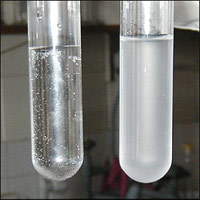A "universe in a test tube" that could be used to assess theories of everything has been created by physicists.
Inside the tube an isotope of helium (called helium three) forms a "superfluid", an ordered liquid where all the atoms are in the same state according to the theory that rules the subatomic domain, called quantum theory.
What is remarkable is that atoms in the liquid, at temperatures within a thousandth of a degree of absolute zero, form structures that, according to the team at Lancaster University, are similar those seen in the cosmos.
"In effect, we have made a universe in a test tube," says Richard Haley, who did the work with Prof George Pickett and other members of the "Ultra-low Temperature Group."
The Holy Grail of physics is to establish an overarching explanation to unite all the particles and forces of the cosmos. But one of the complaints commonly levelled at a leading contender for a "theory of everything", called string theory, is that it is impossible to test.
But now, according to the study in the journal Nature Physics, it may be possible using the universe in a test tube. "It was a serendipitous discovery," says Haley.
The equations used to describe this superfluid turn up in many other branches of physics. "For instance, the internal structure of the superfluid mirrors very closely the structure of space-time itself, the 'background' of the universe in which we live," says Haley.
"Consequently the superfluid can be used to simulate particle and cosmic phenomena; black holes, cosmic strings and the Big Bang for instance.
"This is great for testing theories, since the equations describing helium-3 are well-established enough to say that it is the most complex system for which we already have the 'Theory of Everything'," Haley continues.
"If the analogous experiments don't work in helium-3, then it's probably time to go back to the drawing board (or computer) with your latest pet theory."
Since the pioneering work of Albert Einstein, the quest for a theory of everything has depended on combining theories of the very small (quantum theory) and the very large (relativity).
One of the strangest features of such theories is that they require the universe to have more than three spatial dimensions to unify our picture of all forces and all matter. One promising candidate is supersymmetric string theory, in which ripples on strings are interpreted as particles. But, to their surprise, physicists found five superstring theories. Now the Lancaster experiments provide new insights into the phenomena predicted by these theories.
For the past three decades it has been known that strings are one member of a bigger class of objects called branes, which exist in higher dimensional space, that could be extended in more than one dimension - from strings of one dimension, to membranes of two dimensions, to those of p dimensions, dubbed p-branes. Moreover string theories and p-branes are facets of one underlying 11-dimensional M theory, which suggests that we live in a brane world: a four-dimensional surface, or brane, in a higher dimensional mixture of space and time.
People and most particles move in the brane, while the higher dimensions provide a framework to unify all forces, from gravity to those that act between atomic particles. While experiments have begun to highlight cracks in the current best theory, called "the standard model", there is evidence that M theory's extra hidden dimensions could be revealed next year when a Geneva atom smasher - the £4.4 billion Large Hadron Collider - begins experiments. But the Lancaster team offers another route to address this impasse.
One idea is that a collision between a brane and an antibrane could have triggered the Big Bang itself. This can now be simulated in superfluid helium within the little test tube.


